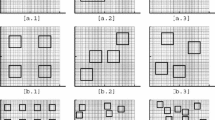Abstract
As most fractures of ductile materials in metal forming processes occurred due to the results of evolution of internal damage — void nucleation, growth and coalescence. In this paper, an approximate yield criterion for voided (porous) anisotropic ductile materials is developed. The proposed approximate yield function is based on Gurson’s yield function in conjunction with the Hosford’s non-quadratic anisotropic yield criterion in order to consider the characteristic of anisotropic properties of matrix material. The associated flow rules are presented and the laws governing void growth with strain are derived. Using the proposed model void growth of an anisotropic sheet under biaxial tensile loading and its effect on sheet metal formability are investigated. The yield surface of voided anisotropic sheet and void growth with strain are predicted and compared with the experimental results.
Similar content being viewed by others
References
Barlat, F. and Lian, J., 1989, “Plastic Behavior and Stretchability of Sheet Metals, Part I: A Yield Function for Orthotropic Sheets Under Plane Stress Conditions,”Int. J. of Plasticity, Vol. 5, pp. 51–66.
Cristian, V., Hosford, F., 1983, “Yield Loci of Anisotropic Sheet Metals,”Int. J. Mech. Sci., Vol. 25(12), pp. 889–915.
Doege, E., Bagaviev, A. and Dohrmann, H., 1997, “Formability Analysis Based on the Anisotropically Extended Gurson Model,”Advanced Methods in Materials Processing Defects, Ed. M. Predeleanu and P. Gilormini, pp. 281–288.
Goodwin, G. M., 1968 “Application of Strain Analysis to Sheet Metal Forming Problems in the Press Shop,”SAE Paper, No. 680093.
Graf, A. and Hosford, W. F., 1993, “Effect of Changing Strain Paths on Forming Limit Diagrams of A1 2008-T4,”Meta. Trans., Vol. 24A, p. 2503.
Gurson, A. L., 1977, “Continuum Theory of Ductile Rupture by Void Nucleation and Growth: Part I — Yield Criteria and Flow Rules for Porous Ductile Materials,”J. Eng. Mater. Tech. ASME, Vol. 99, pp. 2–15.
Hill, R., 1948, “A Theory of the Yielding and Plastic Flow of Anisotropic Metals,”Proc. R. Soc. London, pp. 281–297.
Hill, R., 1950,The Mathematical Theory of Plasticity, Oxford University Press, London.
Hill, R., 1979, “Theoretical Plasticity of Textured Aggregates,”Math. Proc. Camb. Phil. Soc., Vol. 85, pp. 179–191.
Hosford, W. F., 1979, “On Yield Loci of Anisotropic Cubic Metals,”Proc. 7th North Am. Metalworking Conf., SME, Dearborn, MI, pp. 191–196.
Hosford, W.F., 1988, “Limitations of Non-Quadratic Anisotropic Yield Criteria and Their Use in Analysis of Sheet Forming, In:Proc. of the 15th IDDRG Congr. A.S.M., Dearborn, MI, pp. 163–170.
Jalinier, J., 1978, Endommagement, Instabilite Plastique et Courbes Limites de Formage. Docteur-Ingenier Thesis, L’institut National Polytechnique de Lorraine, France.
Keeler, S. P., 1965 “Determination of Forming Limits in Automotive Stampings,”SAE paper, No. 650635.
Kuwabara, T., IKeda, S. and Kuroda, K., 1998, “Measurement and Analysis of Differential Work Hardenings in Cold-Rolled Steel Sheet Under Biaxial Tension,”J. Mater. Proc. Tech., Vol. 80, pp. 517–523.
Lee, U., 1998, “A Continuum Mechanics for Damaged Anisotropic Solids,”KSME Int. J., Vol. 12, No. 3, pp. 405–413.
Liao, K.C., Pan, J. and Tang, S.C., 1997, “Approximate Yield Criteria for Anisotropic Porous Ductile Sheet Metals,”Mechanics of Materials, Vol. 26, pp. 213–226.
Luo, Z.J., Ji, W.H., Guo, N.C., Xu, X.Y., Xu, Q.S., Zhang, Y.Y., 1992, “A Ductile-Damage Model and Its Application to Metal-Forming Processes,”J. Mat. Proc. Tech. Vol. 30, pp. 31–43.
Marciniak, Z. and Kuczynski, K., 1967, “Limit Strains in the Process of Stretch-Forming Sheet Metal,”Int. J. Mech. Sci. Vol. 9, pp. 609–620.
Parmar, A. and Mellor, P.B., 1980, “Growth of Voids in Biaxial Stress Fields,”Int. J. Mech. Sci., Vol. 22, pp. 133–150.
Storen, S. and Rice, J., 1975, “Localized Necking in Thin Sheets,”J. Mech. Phys. Solids, Vol. 23, pp. 421–441.
Tvergaard, V., 1987, “Effect of Yield Surfaces Curvatures and Void Nucleation on Plastic Flow Localization,”J. Mech. Phys. Solids, Vol. 35(1), pp. 43–60.
Tvergaard, V., 1991, “Mechanical Modelling of Ductile Fracture,”Mechanica, Vol. 26, pp. 11–16.
Zhao, L., Sowerby, R. and Sklad, M.P., 1996, “A Theoretical and Experimental Investigation of Limit Strains in Sheet Metal Forming,”Int. J. Mech. Sci., Vol. 38, pp. 1307–1317.
Author information
Authors and Affiliations
Corresponding author
Rights and permissions
About this article
Cite this article
Kim, Y., Won, S., Kim, D. et al. Approximate yield criterion for voided anisotropic ductile materials. KSME International Journal 15, 1349–1355 (2001). https://doi.org/10.1007/BF03185676
Received:
Revised:
Issue Date:
DOI: https://doi.org/10.1007/BF03185676




